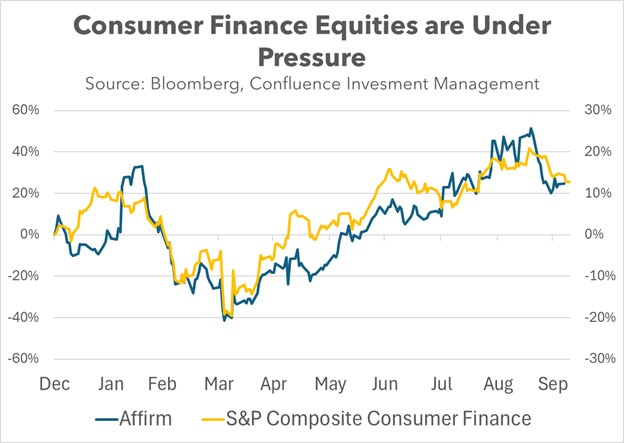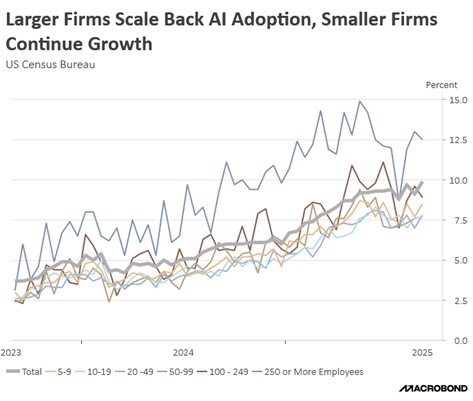by Patrick Fearon-Hernandez, CFA, and Thomas Wash
[Posted: 9:30 AM ET] | PDF
Our Comment today opens with the latest dramatic policy announcements on US-China relations, which drove stock prices sharply lower on Friday before a reversal gave stocks a boost this morning. We next review several other international and US developments with the potential to affect the financial markets today, including a big new investment in US defense firms, mineral producers, and artificial-intelligence firms by JPMorgan and a growing chance that the long ruling Liberal Democratic Party could lose power in Japan.
United States-China: There was a sudden rekindling of US-China tensions on Friday, when President Trump said he would impose an additional 100% tariff on US imports from China, restrict critical US exports, and possibly cancel his summit with General Secretary Xi this month. However, Trump and Vice President Vance both made more conciliatory statements over the weekend. The renewed trade tensions had weighed heavily on global stock and cryptocurrency assets on Friday, but the more conciliatory statements have boosted asset values so far today.
- The initial move by Trump on Friday was in response to Beijing’s decision to further tighten its curbs on Chinese exports of critical minerals and the technology to mine and process them, which we described in our Comment last week.
- The renewed US export curbs apparently would have included critical software and aircraft parts. That’s a reminder that US producers of those items could face reduced sales in China if the trade dispute worsens again.
- Months ago, the reciprocal US and Chinese export controls of critical products helped prompt a truce in the US-China trade war. All the same, the experience during the spring has taught each side where its economic leverage really lies. Despite China’s huge reliance on exports to the US, perhaps the key takeaway is that Beijing has developed important leverage against Washington with its control of critical minerals and its ability to shut its domestic market to US goods ranging from soybeans to semiconductors.
- Coupled with China’s growing military, technological, and diplomatic strength, its newly realized economic strength raises the likelihood that the US will have to back down and accept a long-term compromise such as the one we described in our Comment last week, i.e., US acquiescence in a Chines takeover of Taiwan and a cut in US import tariffs in exchange for more Chinese investment in the US. Indeed, the White House’s reversal at the weekend helps confirm that this is a possibility.
- In the short-to-medium term, such a deal would likely be positive for US and Chinese stocks, as it would remove an important geopolitical risk. By allowing China to increase its global influence, however, such a deal would likely be negative for US economic and financial prospects in the long run.
US Defense Industry: JPMorgan Chase today said it will directly invest $10 billion of its own capital over the next 10 years in a range of companies deemed critical to US national security and economic resiliency. The targeted firms are expected to include defense contractors, mineral producers, and artificial-intelligence firms. According to the bank, its investments will facilitate a total of $1.5 trillion in additional capital for the firms.
- We think the program also underscores our longstanding belief that rising Great Power competition will spur stronger defense spending and programs for economic resiliency across the globe, although we continue to believe that the threat from Russia will make the trend more pronounced in Europe.
- JPMorgan is probably also responding to the US administration’s penchant for taking direct stakes in critical companies, which has often sharply boosted their share prices.
US Critical Minerals Industry: The Pentagon’s Defense Logistics Agency has said it’s looking to buy up to $1 billion of critical minerals to add to the US’s national security stockpile as it seeks to reduce China’s ability to crimp US defense production by withholding supplies. Some of the targeted minerals have not previously been stockpiled. The program could give a boost to many mining and mineral processing firms.
US Economy: In its latest regular survey of economists, the Wall Street Journal found that the respondents have ratcheted up their forecasts of near-term US economic growth, with an average expectation that fourth-quarter gross domestic product will be up 1.7% from a year earlier, compared with a forecast of just 1.0% in July. However, they maintained their forecast of 1.9% growth for 2026. The increased growth forecasts generally reflect looser monetary and fiscal policy combined with reduced policy uncertainty.
- Despite expecting less Federal Reserve independence and improved growth, the economists have lowered their forecasts for consumer price inflation.
- In part, that reflects their expectation for a much softer labor market and a modest rise in unemployment.
Netherlands-China: In a sign of continued Europe-China tensions, the Dutch government said it has taken control of Netherlands-based semiconductor company Nexperia from its Chinese owner to keep Europe from losing “technological knowledge and capabilities” necessary for its economic security. According to Dutch officials, the move was taken after the government picked up “signals of serious governance shortcomings and actions within Nexperia.”
- Nexperia’s Chinese owner, Wingtech Technology, suggested the Dutch move resulted from the US’s recent blacklisting of several Chinese firms, including Wingtech, along with their subsidiaries. Nexperia evidently could have been subject to US sanctions, raising the risk that Wingtech would bring its operations back to China.
- In any case, the incident is the latest evidence of how countries are working feverishly to secure their critical supply chains and shore up their domestic industrial and technological capabilities. These moves will create both risks and opportunities for investors.
Japan: The centrist Komeito party is talking with several smaller opposition parties about backing Yuichiro Tamaki, leader of the Democratic People’s Party, in the upcoming Diet vote for a new prime minister. Komeito quit its long role as junior partner to the ruling Liberal Democratic Party only on Friday, so the sudden coalescing of opposition parties against the LDP is a shock to Japan’s political system. It also raises doubts as to whether the LDP’s new chief, the conservative, pro-market Sanae Takaichi, will really become the new prime minister as expected.
- Optimism that Takaichi would again implement the stimulative “Abenomics” policies of former Prime Minister Abe had given a big boost to Japanese stock prices in recent weeks. Now that Komeito has pulled out of the ruling coalition and is talking with other parties about supporting a rival candidate, investors are much less certain about Takaichi’s ascension.
- As a result, Japanese stock values have pulled back over the last few days. If Takaichi’s future becomes even more uncertain, Japanese stocks could soften further.
France: Late Friday, President Macron again nominated Sébastien Lecornu to be prime minister, just days after Lecornu resigned from his first stint in the position after only a month. Macron’s decision has been widely criticized as a sign that the president is running out of options for his government. Popular opinion also increasingly criticizes Macron for refusing to respect the people’s rejection of his plan for fiscal tightening to cut France’s rising debt. The political chaos in France is likely to continue weighing on French and European asset values.
Pakistan-Afghanistan: The Pakistani and Afghan armed forces have engaged in a series of border skirmishes in recent days, culminating in dozens of deaths on each side over the weekend. The fighting has sparked concerns that the violence could lead to a broader conflict between the two countries, whose governments have become increasingly hostile to each other in recent months over Islamabad’s accusation that Afghanistan is harboring anti-Pakistani militants on its side of the border.





